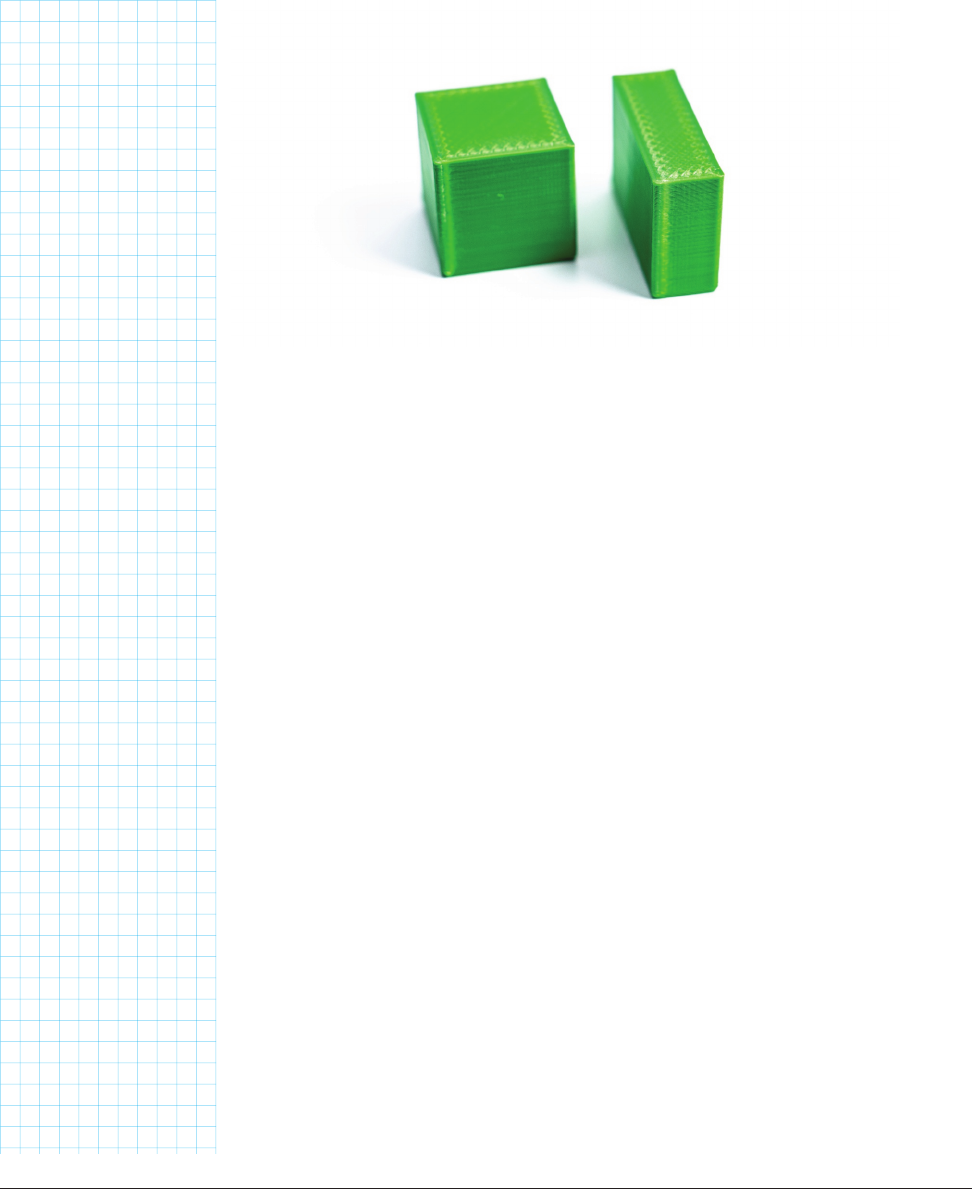
8
CHAPTER 8
VOLUME,
D EN S I T Y, A N D
DISPLACEMENT
Make: Geometry 151
150 Chapter 8: Volume, Density, and Displacement
Geometry_Chapter10_v15.indd 150Geometry_Chapter10_v15.indd 150 6/23/2021 9:10:04 AM6/23/2021 9:10:04 AM
In this chapter, we will explore three related topics: volume, density, and displacement. First, we calcu-
late volume, which tells us how much space there is inside an object. Then we’ll move on to density (how
much mass there is in a given volume). We will wind up showing you how to measure displacement, how
much water is equivalent in mass and/or volume to a solid object. (There is a concept of displacement
in more advanced geometry, too— it is the shortest distance between two locations of a moving object.
But we will not be using the word in that sense here. We are sticking to the more common nautical
definition.)
You might wonder why we are doing what you might think of as physics in a geometry book. We want
you to experience how geometry is used every day. One thing that is particularly fun about the content
in this chapter is that we will be able to show you how you can calculate and measure volume, density,
and displacement in the real world, and see that your calculations work beyond just having them on the
page.
Like a lot of geometry, ways to calculate the volume of various 3D shapes have been known for well over
2000 years, since there are so many practical everyday applications for knowing how much a box or jar
can hold. You also might want to know the contents of a container without necessarily opening it, so how
much a certain volume of grain or gold should weigh is handy to know, too.
Ancient Greeks or Egyptians could tell if two masses were equal (or heavier or lighter relative to each
other) by using a balance. A balance is a simple scale with two pans on a bar, connected to a pivot; if the
two pans contain the same mass, the bar connecting them is level. If one side of the balance is heavier
than the other, the crossbar rotates on the pivot, and that side sits lower. A balance is the instrument
we see statues of Justice holding. But a balance couldn’t do very good absolute measurements. That is,
they couldn’t easily tell that something had a mass of precisely 8.2 grams.
To measure mass and densities within those limitations, a little over 2000 years ago the Greek math-
ematician and engineer Archimedes came up with the concept of displacement. Displacement lets us
use the known density of water versus other materials to see if golden crowns, for example, really were
what the seller claimed them to be.
Archimedes’ discovery is one of the classic science-discovery stories. It might or might not be a true
story, since it has come down to us indirectly from sources written long after the fact. But, it’s such a
fun story that it should be true, so, with that grain of salt...
Archimedes lived in the city of Syracuse, on the island of Sicily. At the time Sicily was part of Greece. He
was pretty oblivious to politics and a lot of other daily-life trivialities, but was so good at what he did that
whoever was in charge at the time wanted his advice. For example, King Hiero II of Syracuse suspected
that his crown-maker had kept some of the gold that was supposed to be for a new crown, replacing it
with a less valuable metal. The king turned to Archimedes for an assessment.
Make: Geometry 151
Geometry_Chapter10_v15.indd 151Geometry_Chapter10_v15.indd 151 6/23/2021 9:10:04 AM6/23/2021 9:10:04 AM

Archimedes thought about it, and he
knew that gold was denser than any
other metal they might have used. If he
knew the volume of the crown, he could
compare it to an equal mass of gold.
Since the crown was a complicated
shape, though, there was no easy way
to measure its volume. Then, one day,
getting into a bathtub, he saw that some
water sloshed out. He realized that
he could put this complicated-shaped
crown in some water, and find out its
volume because an equal volume of
water would be displaced. As we’ll see
in this chapter, this allows us to get on
the path to measuring the density of an
object of unknown composition.
In the most common version of the
story, he was so excited about this that
it is said that he ran naked through the
streets of Syracuse, shouting, “Eureka!”
(Greek for “I have found it”). And so
today we have “a eureka moment” as a
moment when a great discovery comes
about. Your authors live in California,
whose state motto is, “Eureka!”
(harkening back to our gold rush days).
The crown maker? The tale goes that he
was indeed crooked, and presumably
dealt with. Not a eureka moment for him.
Hopefully, we can lead you to your
own eureka moments in this chapter,
although we suggest dressing first
before running off to tell your friends.
Let’s see how much we can learn about
volume, density, and displacement with
very simple measuring devices, and also
see how Archimedes solved the crime.
3D Printable Models Used in this
Chapter
See Chapter 2 for directions on where and how to down-
load these models.
sphere_cone_volume.scad
Prints out a cone, half-sphere, and cylinder with volume
ratio 1:2:3
prism.scad
Prints an n-sided prism (flat top and bottom) with a spec-
ified volume
pyramid.scad
Prints an n-sided pyramid (becomes a cone for n >100)
with a specified volume. The top can also skew away
from the center while maintaining the volume.
3_pyramid_puzzle.scad
Prints 3 pyramids which collectively form a cube
Other supplies for this chapter
• A scale (ideally, a postal or kitchen scale that can
measure to fractions of a gram)
• About 1/4 cup of table salt, sand, or other fine
granular substance that does not pack down when
compressed.
• A calculator
• Measuring cup or graduated cylinder with detailed
markings, ideally in mL
• A basin of water
• A few metal coins and other objects that can be sub-
merged in water
Make: Geometry 153
152 Chapter 8: Volume, Density, and Displacement
Geometry_Chapter10_v15.indd 152Geometry_Chapter10_v15.indd 152 6/23/2021 9:10:04 AM6/23/2021 9:10:04 AM

VOLUME
There are a lot of practical applications of knowing the volume of 3D objects
(specifically, cones, spheres, and cylinders). Back in Chapter 3, we learned
about regular polyhedrons and how to make them in OpenSCAD.
Not surprisingly, we measure volume in units of length cubed — that is,
extended into all three spatial dimensions. A standard unit of volume is the
liter, which is precisely one-tenth of a meter squared. A thousandth of a liter,
a milliliter (mL) is also equal to 1 cm
3
.
It turns out that there are simple relationships among the volumes of a
sphere, cylinder, and cone. Let’s look at each in turn, and then tie them
together.
VOLUME OF A RECTANGULAR SOLID
If the sides of a polyhedron are rectangles instead of squares (for example, a
box), we can pick one side and call it the base. Then the volume of this rect-
angular solid is just the area of the base times the height, or length * width *
height.
Volume = base * height
A cube is a six-sided regular polyhedron. All its sides are squares. In this
case, since the length, width, and height are all the same, we can use any
side and just cube it.
Volume = side
3
In OpenSCAD, all rectangular solids are created with the “cube” function. For
example, a rectangular solid that is 10 by 30 by 20 mm would be created in
OpenSCAD with this line:
cube([10, 30, 20]);
An actual cube could either be the same line with all the numbers the same,
or just this (for a cube 20mm on a side):
cu b e(20);
Figure 8-1 shows the results of these two single-line models. We haven’t
Make: Geometry 153
Geometry_Chapter10_v15.indd 153Geometry_Chapter10_v15.indd 153 6/23/2021 9:10:04 AM6/23/2021 9:10:04 AM

provided a model for rectangular solids given that it is probably simpler to
type in one line than to hunt around in the repository for them.
VOLUME OF PRISMS
Now we’ll tie together a few ideas that will let you see that these formulas
hold for some other shapes as well. Pieces of this analysis go back 2300
years or so to Archimedes in ancient Greece. The form we will talk about
here though is attributed to Bonaventura Cavalieri, who was active in the
mid-1600s, just before Newton. Some of the ideas in this chapter are a good
lead-in to calculus as well.
Imagine that we have a prism. A prism is a 3D shape with identical, parallel
polygons at both ends, and flat faces connecting the sides. For example, a
triangular prism has identical triangles on top and bottom, and three flat
rectangular sides. A cube is a prism, too, which happens to have all its sides
the same.
One of these sides is considered the base, and the height is measured per-
pendicular to the base. As with a rectangle, the volume of a prism is just the
area of the base times the height. Therefore, if two prisms have the same
base area, regardless of the shape, and the same height, they will have the
same volume.
If the top is directly over the base (and thus the sides make right angles with
the base and top) it is called a right triangular prism (if the cross-section is
triangular), a right rectangular prism (if the base is a rectangle), and so on.
FIGURE 81: A rectangular solid and a cube.
Make: Geometry 155
154 Chapter 8: Volume, Density, and Displacement
Geometry_Chapter10_v15.indd 154Geometry_Chapter10_v15.indd 154 6/23/2021 9:10:05 AM6/23/2021 9:10:05 AM
..................Content has been hidden....................
You can't read the all page of ebook, please click here login for view all page.
